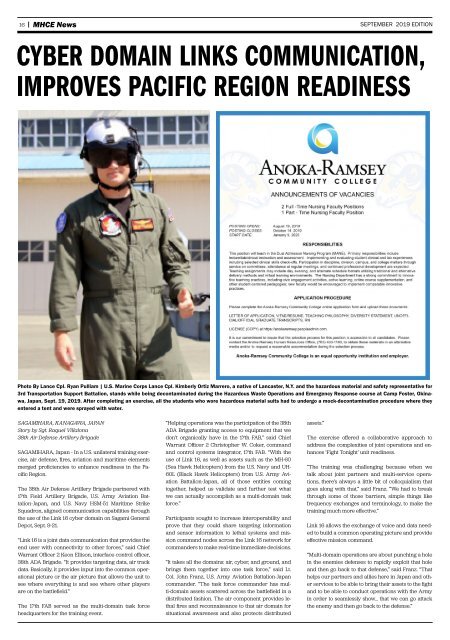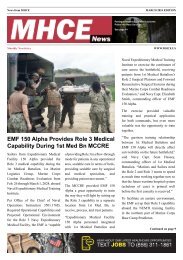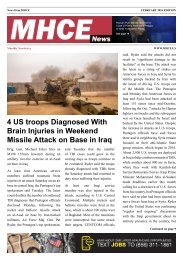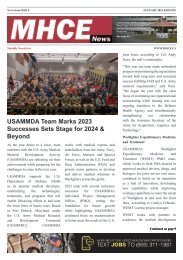MHCE September 2019 Publication
MHCE September 2019 Publication
MHCE September 2019 Publication
Create successful ePaper yourself
Turn your PDF publications into a flip-book with our unique Google optimized e-Paper software.
16<br />
<strong>MHCE</strong> News<br />
SEPTEMBER <strong>2019</strong> EDITION<br />
CYBER DOMAIN LINKS COMMUNICATION,<br />
IMPROVES PACIFIC REGION READINESS<br />
Photo By Lance Cpl. Ryan Pulliam | U.S. Marine Corps Lance Cpl. Kimberly Ortiz Marrero, a native of Lancaster, N.Y. and the hazardous material and safety representative for<br />
3rd Transportation Support Battalion, stands while being decontaminated during the Hazardous Waste Operations and Emergency Response course at Camp Foster, Okinawa,<br />
Japan, Sept. 19, <strong>2019</strong>. After completing an exercise, all the students who wore hazardous material suits had to undergo a mock-decontamination procedure where they<br />
entered a tent and were sprayed with water.<br />
SAGAMIHARA, KANAGAWA, JAPAN<br />
Story by Sgt. Raquel Villalona<br />
38th Air Defense Artillery Brigade<br />
SAGAMIHARA, Japan – In a U.S. unilateral training exercise,<br />
air defense, fires, aviation and maritime elements<br />
merged proficiencies to enhance readiness in the Pacific<br />
Region.<br />
The 38th Air Defense Artillery Brigade partnered with<br />
17th Field Artillery Brigade, U.S. Army Aviation Battalion-Japan,<br />
and U.S. Navy HSM-51 Maritime Strike<br />
Squadron, aligned communication capabilities through<br />
the use of the Link 16 cyber domain on Sagami General<br />
Depot, Sept. 9-21.<br />
“Link 16 is a joint data communication that provides the<br />
end user with connectivity to other forces,” said Chief<br />
Warrant Officer 2 Keon Ellison, interface control officer,<br />
38th ADA Brigade. “It provides targeting data, air track<br />
data. Basically, it provides input into the common operational<br />
picture or the air picture that allows the unit to<br />
see where everything is and see where other players<br />
are on the battlefield.”<br />
The 17th FAB served as the multi-domain task force<br />
headquarters for the training event.<br />
“Helping operations was the participation of the 38th<br />
ADA Brigade granting access to equipment that we<br />
don’t organically have in the 17th FAB,” said Chief<br />
Warrant Officer 2 Christopher W. Coker, command<br />
and control systems integrator, 17th FAB. “With the<br />
use of Link 16, as well as assets such as the MH-60<br />
(Sea Hawk Helicopters) from the U.S. Navy and UH-<br />
60L (Black Hawk Helicopters) from U.S. Army Aviation<br />
Battalion-Japan, all of those entities coming<br />
together, helped us validate and further test what<br />
we can actually accomplish as a multi-domain task<br />
force.”<br />
Participants sought to increase interoperability and<br />
prove that they could share targeting information<br />
and sensor information to lethal systems and mission<br />
command nodes across the Link 16 network for<br />
commanders to make real-time immediate decisions.<br />
“It takes all the domains: air, cyber, and ground, and<br />
brings them together into one task force,” said Lt.<br />
Col. John Franz, U.S. Army Aviation Battalion-Japan<br />
commander. “The task force commander has multi-domain<br />
assets scattered across the battlefield in a<br />
distributed fashion. The air component provides lethal<br />
fires and reconnaissance to that air domain for<br />
situational awareness and also protects distributed<br />
assets.”<br />
The exercise offered a collaborative approach to<br />
address the complexities of joint operations and enhances<br />
‘Fight Tonight’ unit readiness.<br />
“The training was challenging because when we<br />
talk about joint partners and multi-service operations,<br />
there’s always a little bit of colloquialism that<br />
goes along with that,” said Franz. “We had to break<br />
through some of those barriers, simple things like<br />
frequency exchanges and terminology, to make the<br />
training much more effective.”<br />
Link 16 allows the exchange of voice and data needed<br />
to build a common operating picture and provide<br />
effective mission command.<br />
“Multi-domain operations are about punching a hole<br />
in the enemies defenses to rapidly exploit that hole<br />
and then go back to that defense,” said Franz. “That<br />
helps our partners and allies here in Japan and other<br />
services to be able to bring their assets to the fight<br />
and to be able to conduct operations with the Army<br />
in order to seamlessly show… that we can go attack<br />
the enemy and then go back to the defense.”


















